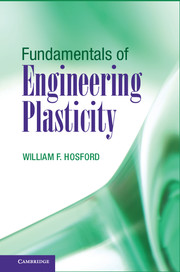Book contents
- Frontmatter
- Contents
- Preface
- 1 An Overview of the History of Plasticity Theory
- 2 Yielding
- 3 Stress and Strain
- 4 Isotropic Yield Criteria
- 5 Bounding Theorems and Work Principles
- 6 Slip-Line Field Theory
- 7 Anisotropic Plasticity
- 8 Slip and Dislocations
- 9 Taylor and Bishop and Hill Models
- 10 Pencil Glide Calculations of Yield Loci
- 11 Mechanical Twinning and Martensitic Shear
- 12 Effects of Strain Hardening and Strain-Rate Dependence
- 13 Defect Analysis
- 14 Effects of Pressure and Sign of Stress State
- 15 Lower-Bound Models
- 16 Plasticity Tests
- Index
- References
8 - Slip and Dislocations
Published online by Cambridge University Press: 05 June 2013
- Frontmatter
- Contents
- Preface
- 1 An Overview of the History of Plasticity Theory
- 2 Yielding
- 3 Stress and Strain
- 4 Isotropic Yield Criteria
- 5 Bounding Theorems and Work Principles
- 6 Slip-Line Field Theory
- 7 Anisotropic Plasticity
- 8 Slip and Dislocations
- 9 Taylor and Bishop and Hill Models
- 10 Pencil Glide Calculations of Yield Loci
- 11 Mechanical Twinning and Martensitic Shear
- 12 Effects of Strain Hardening and Strain-Rate Dependence
- 13 Defect Analysis
- 14 Effects of Pressure and Sign of Stress State
- 15 Lower-Bound Models
- 16 Plasticity Tests
- Index
- References
Summary
Plastic deformation of crystalline materials usually occurs by slip, which is when the sliding of planes of atoms slide over one another (Figure 8.1). The planes on which slip occurs are called slip planes and the directions of the shear are the slip directions. These are crystallographic planes and directions, and are characteristic of the crystal structure. The magnitude of the shear displacement by slip is an integral number of inter-atomic distances, so that the lattice is left unaltered by slip. If slip occurs on only a part of a plane, there remains a boundary between the slipped and unslipped portions of the plane, which is called a dislocation. It is the motion of these dislocations that cause slip.
Slip lines can be seen on the surface of deformed crystals. The fact that we can see these indicates that slip is inhomogeneous on an atomic scale. Displacements of thousands of atomic diameters must occur on discrete or closely spaced planes to create steps on the surface that are large enough to be visible. Furthermore, the planes of active slip are widely separated on an atomic scale. Yet the scale of the slip displacements and distances between slip lines are small compared to most grain sizes so slip usually can be considered as homogeneous on a macroscopic scale.
- Type
- Chapter
- Information
- Fundamentals of Engineering Plasticity , pp. 83 - 117Publisher: Cambridge University PressPrint publication year: 2013



